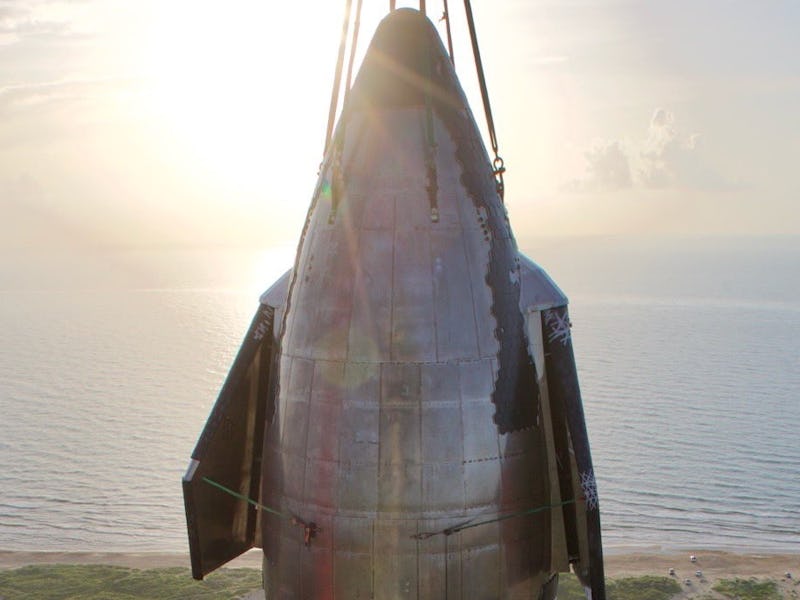SpaceX Starship: 6 jaw-dropping photos show rocket ahead of biggest test
SpaceX's Starship rocket is gearing up for its most ambitious test yet, and CEO Elon Musk has shared images of the rocket stacked up.

It’s finally happened — SpaceX has stacked the Starship, creating what could become the world’s tallest rocket ever to fly.
Over the weekend, spaceflight firm CEO Elon Musk shared photos on Twitter of its fully-stacked rocket at the firm's Texas facility for the first time. The under-development rocket is designed to support SpaceX’s most ambitious future missions, like a city on Mars and transforming humanity into a multi-planet species.
“It will be exciting to see what new cultures humanity creates on other heavenly bodies!” Musk wrote on Twitter.
The Starship stacked up high, on top of the launch platform.
The construction pairs the smaller ship (the one that’s already completed a series of high-altitude tests) with the Super Heavy. This booster is designed to help the ship lift off from Earth’s gravity and is set to support the ship on its first orbital flight this year.
It’s a pivotal moment for Musk and SpaceX. Musk first unveiled the ship’s predecessor back in 2017 under the title “BFR.” The fully-reusable ship is designed to send up to 100 people or 100 tons into space at a time. The ship is intended to replace existing rockets like the Falcon 9 and Falcon Heavy while enabling the firm’s bigger plans.
Its use of liquid oxygen and methane as a fuel, as opposed to the rocket propellant found on the Falcon 9, means astronauts could fly to Mars, refuel using the planet’s resources, and either return home or venture out further.
Musk described the fully stacked rocket as a “dream come true.”
Want to find out more about SpaceX and Starship? Subscribe to MUSK READS+ for exclusive interviews and analysis about spaceflight, electric cars, and more.
SpaceX Starship stacked with the sunlight in the background.
SpaceX Starship: how the photos reveal its true size
As is perhaps clear from the images, this rocket is giant. The ship alone measures around 160 feet, while the Super Heavy booster measures 230 feet. Taken together, the pair reach an estimated 394 feet in height.
The rocket’s sheer size has been a point of fascination ever since its predecessor was unveiled in 2017. For comparison, SpaceX's Falcon 9 and Falcon Heavy ships measure 229.6 feet tall. United Launch Alliance’s Atlas V rocket measures around 197 feet tall.
The tallest rocket to ever fly was NASA’s Saturn V, which measured 363 feet tall. It was also the most powerful rocket yet flown, with 7.6 million pounds of thrust at launch.
If SpaceX’s rocket flies, it will take both records from the Saturn V — the Super Heavy booster will produce 16 million pounds of thrust at liftoff.
SpaceX Starship moving into position onto the Super Heavy booster.
Musk also shared an image of the Starship reminiscent of the iconic “Lunch atop a Skyscraper” photo.
SpaceX Starship with workers observing.
SpaceX Starship: Elon Musk’s plans for the ship
SpaceX Starship getting ready to stack up.
SpaceX plans to host an orbital flight with the ship in the second half of this year. The 90-minute flight will see the ship lift off from the Texas facility, separate from the booster after 171 seconds (when it will soft land in the Gulf of Mexico), and then continue to land around 60 miles off the coast of Hawaii.
Musk explained on Twitter that there are four items still to go before launch:
- The final heat shield tiles need to be completed. These are “~98% done.”
- The booster engines need thermal protection
- The on-the-ground propellant storage tanks need to be completed
- The quick disconnect, or QD, arm for the ship needs to be completed
The heat shields are visible on the ship portion in black. These will be used to protect the ship during its landing.
SpaceX Starship ready to go.
The launch date is unclear, but SpaceX will be keen to launch as quickly as possible. SpaceX president Gwynne Shotwell claimed in June the firm was “shooting for July.”
On June 29, Musk claimed at the Mobile World Congress that "we are going to do our best to do an orbital [Starship] launch attempt in the next few months."
From there, Starship has big plans lined up soon. The firm is aiming to send Japanese billionaire Yusaku Maezawa around the Moon in 2023.
SPACEX STARSHIP ORBITAL FLIGHT: HOW DID WE GET HERE?
- November 2018 — BFR, first announced in September 2017, gets renamed Starship
- December 2018 — Musk confirms the new ship has switched to stainless steel
- January 2019 — Shortened “Starhopper” prototype unveiled, and Musk explains the switch to steel
- February 2019 — Raptor engine beats a long-standing rocket record
- April 2019 — Starhopper completes a tethered “hop”
- July 2019 — Starhopper launches 20 meters (67 feet)
- August 2019 — Starhopper launches 150 meters (500 feet)
- September 2019 — Starship Mk.1 full-size prototype unveiled
- May 2020 — Starship SN4 full-size prototype completes a static test fire
- August 2020 — SN5 launches 150 meters (500 feet)
- October 2020 — SN8 completes the first triple-Raptor static fire
- December 2020 — SN8 launches 12.5 kilometers (41,000 feet) and crashes into the ground
- February 2021 — SN9 launches 10 kilometers (33,000 feet) and crashes into the ground
- March 2021 — SN10 launches 10 kilometers (33,000 feet), lands, and explodes eight minutes later. That same month, SN11 launches 10 kilometers (33,000 feet) and hits the ground in several pieces.
- May 2021 — SN15 launches 10 kilometers (33,000 feet) and lands without a hitch, except for a small fire at the base
SUBSCRIBE TO MUSK READS+, A PREMIUM NEWSLETTER THAT COVERS THE WORLDS OF ELON MUSK, SPACEX, TESLA, AND EVERYTHING BETWEEN.